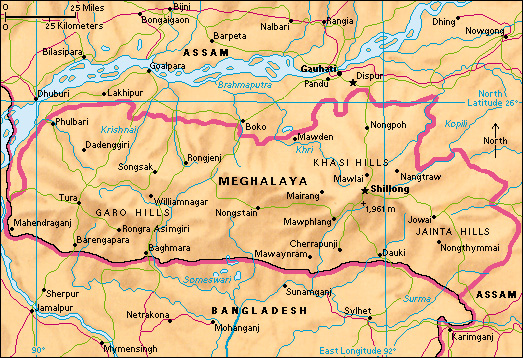Meghalaya (pop. 2,966,889) is a small state in northern India. Meghalaya means abode of the clouds. The south-facing slopes overlooking Bangladesh are famous for their rain. These slopes receive an average of about 450 inches (1,140 centimeters) of rain a year.

Meghalaya is a compact and isolated state, bordered to the north by Assam and to the south by Bangladesh. It covers 8,660 square miles (22,429 square kilometers). Shillong, the capital, is the largest city.
The people.
The people of Meghalaya come mainly from three groups: the Khasis, the Jaiñtias, and the Garos, who are also found in Bangladesh. Each group has its own language.
The Garos came originally from Tibet. Traditionally, they were animists, believing that the souls of the dead and the spirits of nature played an important role in their lives.
The Khasis are an Austro-Asiatic people. This group of peoples lives in certain areas of India and Southeast Asia. They speak a language belonging to the Austro-Asiatic language family, whose other members include Khmer and Vietnamese.
The Jaiñtias, who call themselves the Pnar, are closely related to the Khasis. They believe in the universal presence of God, and so they have built no temples. They commemorate the dead by erecting monoliths (large blocks of stone). Groups of these large stones can be seen in villages in central Meghalaya.
All three groups are matrilineal—that is, they pass down wealth and property through the female line. In the 1800’s, missionaries converted many Garos and Jaiñtias to Christianity, but many old traditions still exist.
Government.
Meghalaya has three elected members in the Lok Sabha (lower house) and one nominated representative in the Rajya Sabha (upper house) of the Indian national parliament. The state legislative assembly has 60 members.
Economy.
The ethnic groups of Meghalaya practice shifting agriculture—that is, they move from one site to another. They grow ginger, oranges, pineapples, and potatoes as cash crops, and rice, corn, and vegetables as food crops. Forest products are among the chief resources of the state. Meghalaya has no large-scale modern industry.
There are rich mineral deposits, including clay, coal, granite, and limestone. Handicrafts and weaving are important, and brightly colored textiles are a specialty.
A network of roads connects Meghalaya with other Indian states. Shillong has a connection by air with Kolkata (formerly called Calcutta).
Land and climate.
Meghalaya’s landscape is mostly rolling plateau. Much of the plateau consists of the same ancient granites that are found in peninsular India. The south-facing slopes overlooking Bangladesh are extremely steep. The hills rise to just under 6,600 feet (2,000 meters), which makes the area cool, despite the fact that it is close to the tropics. There are many lakes and waterfalls.
The state lies in a severe earthquake belt. An earthquake destroyed the entire town of Shillong in 1896.
Pine, sal, and bamboo forests dominate the natural vegetation. Several species of deciduous trees (trees that shed their leaves annually), including birch, beech, and oak, can be found at higher altitudes. Elephants, leopards, tigers, oxen, wild pigs, and many small animals such as deer, gibbons, monkeys, and squirrels are common. The forests have many colorful birds, such as parrots and partridges.
The altitude and heavy cloud keep maximum temperatures in summer down to 73 °F (23 °C), with minimum temperatures falling to 59 °F (15 °C). In winter, the maximum temperature is 61 °F (16 °C) and the minimum, 39 °F (4 °C). The annual rainfall is more than 80 inches (200 centimeters) in Shillong, most of it falling between June and September. The south-facing slopes of Meghalaya are famous for their rain. Cherrapunji has been known to have more than 82 feet (25 meters) of rain in one year, while Mawsynram has an annual average of more than 33 feet (10 meters).
History.
The Khasi, Garo, and Jaiñtia ethnic groups of present-day Meghalaya have lived in the isolated region for thousands of years. Each group has handed down a different account of the early history of the area.
In the 1200’s, the Ahom peoples moved into Assam and recorded in their chronicles the often hostile contacts they had with the local population of Meghalaya. The Meghalayans frequently raided Assam and Bengal. Later, the Meghalayans clashed with the Mughals but were not conquered by them. The British also were unable to conquer Meghalaya, despite sending military expeditions against it to stop continuing raids on Bengal.
Eventually, the British incorporated Meghalaya into Assam in 1835. The Meghalayans accepted overall British control in return for the freedom to pursue their own goals. However, the introduction of Western education caused major changes in the Meghalayans’ way of life, and many of them also converted to Christianity. After Indian independence in 1947, Meghalaya remained part of Assam. In 1969, the Indian government made Meghalaya an autonomous (self-ruled) region within Assam. Meghalaya was granted full statehood in 1972.
